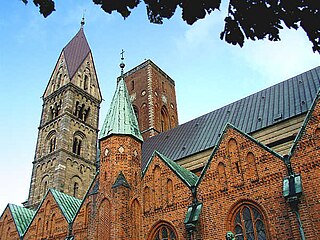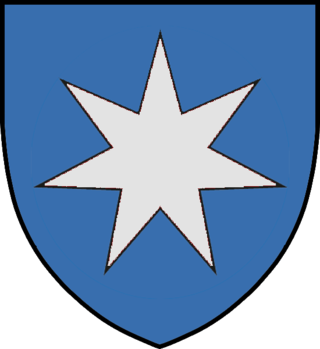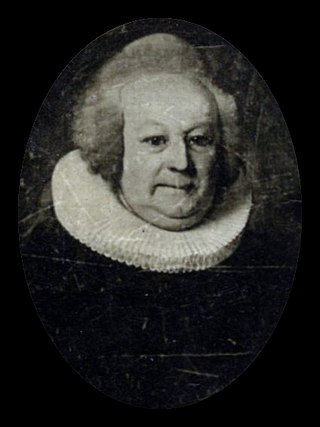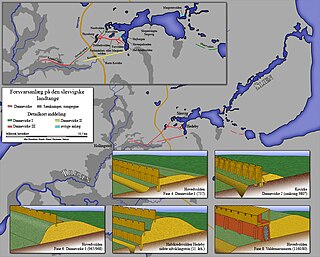External links
Adolf Ditlev Jørgensen, "Aage, – 1167, Biskop i Slesvig", in: Dansk biografisk leksikon , vol. I: Aaberg – Beaumelle, p. 7.
Occo | |
|---|---|
| Bishop of Schleswig | |
| Church | Roman Catholic Church |
| Archdiocese | Lund |
| See | Diocese of Schleswig |
| In office | 1141–1145, and again 1161–1167 |
| Predecessor | Hermann, and Esbern |
| Successor | Esbern, and Frederick I |
| Personal details | |
| Born | unknown |
| Died | 1167 |
Occo of Schleswig (also Aage, Aagge, Ogge) was the bishop of the Diocese of Schleswig between 1141 and 1145 and again from 1161 to 1167.
The chapter of Schleswig Cathedral elected Occo bishop in 1138, after Bishop Rike had been elected the new bishop of Roskilde. [1] However, Eric III Lamb imposed his chaplain Hermann, who was born in the Holy Roman Empire. [1] So Occo was hindered to ascend the see. The city of Schleswig and the diocesan clergy preferred the Bishop elect Occo and after unrest among the townsfolk Hermann resigned, and Occo ascended. [1] Eric Lamb provided for Hermann with another position. [1]
Occo sided – unlike his Archbishop Eskil of Lund – with Olaf Haraldsen who aimed at dethroning his cousin Eric Lamb, but failed. [1] Occo then had to leave and went into French exile. [1] Eskil then consecrated Esbern as new bishop of Schleswig. The royal steward (or stadholder) for Schleswig, Nicolaus, ravaged Esberns's possessions and his residence (Old Gottorp). [2] So Esbern's relatives protected him and killed Nicolaus. [2] Fearing the royal revenge Esbern fled to Saxony, where he died in 1161. [2]
King Valdemar I the Great then reappointed Occo as bishop. [1] This made Eskil inflicting the ban on Occo, but due to internal quarrels in the church the bishop of Schleswig managed to stay in office until his death. [1] Starting in 1161 Occo built a new Gottorp Castle, replacing the destroyed one, however, on another site.
Adolf Ditlev Jørgensen, "Aage, – 1167, Biskop i Slesvig", in: Dansk biografisk leksikon , vol. I: Aaberg – Beaumelle, p. 7.

Absalon was a Danish statesman and prelate of the Catholic Church who served as the bishop of Roskilde from 1158 to 1192 and archbishop of Lund from 1178 until his death. He was the foremost politician and church father of Denmark in the second half of the 12th century, and was the closest advisor of King Valdemar I of Denmark. He was a key figure in the Danish policies of territorial expansion in the Baltic Sea, Europeanization in close relationship with the Holy See, and reform in the relation between the Church and the public. He combined the ideals of Gregorian Reform with loyal support of a strong monarchical power.

Frederick I was King of Denmark and Norway. He was the last Roman Catholic monarch to reign over Denmark and Norway, when subsequent monarchs embraced Lutheranism after the Protestant Reformation. As king of Norway, Frederick is most remarkable in never having visited the country and was never crowned as such. Therefore, he was styled King of Denmark, the Vends and the Goths, elected King of Norway. Frederick's reign began the enduring tradition of calling kings of Denmark alternatively by the names Christian and Frederick, which has continued up to the reign of the current monarch, Margrethe II.

Canute VI was King of Denmark (1182–1202). Contemporary sources describe Canute as an earnest, strongly religious man.

Eric IV, also known as Eric Ploughpenny or Eric Plowpenny, was King of Denmark from 1241 until his death in 1250. His reign was marked by conflict and civil wars against his brothers.

August Philipp, Duke of Schleswig-Holstein-Sonderburg-Beck was a Danish-German prince and member of the House of Oldenburg. After acquiring the estate of Beck in Westfalen in 1646, he took the title of Duke of Schleswig-Holstein-Sonderburg-Beck.

Princess Louise of Denmark and Norway was born to Frederick V of Denmark and Louise of Great Britain. Her eldest daughter, Marie of Hesse-Kassel, was the wife of Frederick VI of Denmark.

Prince Charles of Hesse-Kassel was a cadet member of the house of Hesse-Kassel and a Danish general field marshal. Brought up with relatives at the Danish court, he spent most of his life in Denmark, serving as royal governor of the twin duchies of Schleswig-Holstein from 1769 to 1836 and commander-in-chief of the Norwegian army from 1772 to 1814.

The former Diocese of Odense was a Roman Catholic diocese in Denmark which included the islands of Funen, Langeland, Tåsinge, Lolland, Falster, Als, and Ærø. Its episcopal see was located in Odense at St. Canute's Cathedral.

The former Diocese of Ribe was a Roman Catholic diocese in Southern Jutland, Denmark. The diocese was established in 948, and dissolved in 1536 during the Protestant Reformation. Within the newly established protestant Church of Denmark, the Diocese of Ribe effectively replaced its Roman Catholic precursor.

Hvide was a medieval Danish clan, and afterwards in early modern era a Danish noble surname of presumably one surviving branch of leaders of that clan. Before the 16th century it was not used as a surname. It signified the color white.
Valdemar Knudsen was a Danish clergyman and statesman. Valdemar was Bishop of Schleswig from 1188 to 1208, officiated as Steward of the Duchy of Schleswig between 1184 and 1187, and served as Prince-Archbishop of Bremen from 1192 to 1194 and again between 1206 and 1217. He held the latter office on the grounds of the archdiocesan capitular election as archbishop elect and of the royal investiture with the princely regalia, but lacked the papal confirmation.

The Ordre de l'Union Parfaite was created by Queen consort Sophie Magdalene of Denmark and Norway on 7 August 1732 to celebrate the tenth anniversary of her happy marriage with King Christian VI of Denmark and Norway. It was given to both men and women. Its motto was In felicissimæ Unionis Memoriam.
Nicholas I was Bishop of Schleswig between 1209 and 1233. Since 1192 he de facto, though not consecrated, officiated during the flight and following royal captivity of his predecessor Bishop Valdemar (1193–1206).

Nordborg Castle is a small castle which lies on the southern side of Nordborg Lake in Nordborg on the island of Als in Sønderborg Municipality, Denmark. The castle premises are currently used by Nordborg Slots Efterskole as a boarding school. Nordborg Castle has also been the backdrop for a number of years for Nord-Als Musikfestival.

Marcus Fredrik Bang was a Danish-Norwegian priest. He was the bishop of the Diocese of Trondhjem from 1773 until 1787. He was born in Næstved, Denmark in 1711 and died in 1789 in Trondheim, Norway.

Falkensteen is a manor house located five kilometres south of Slagelse, Denmark. The current Neoclassical main building was built for Georg Frederik Ditlev Koës in 1775. It was listed on the Danish registry of protected buildings and places in 1950. A half-timbered barn from 1864 is also listed.

Hermann of Schleswig, also known as Hermann of Klosterrath, was a titular bishop of Schleswig, canon and possibly also scribe at Lund Cathedral. He entered the monastery of Rolduc at an early age, and after failing to become abbot of the monastery eventually left for Lund. He provided several services to the bishops of Lund and was appointed to become bishop of Schleswig, but the local clergy had elected Occo of Schleswig in 1137 as their bishop and refused to accept Hermann. He therefore remained in Lund, where he is buried in the crypt of Lund Cathedral.

A Meeting in the Royal Danish Academy of Sciences and Letters is a monumental 1897 oil-on-canvas group portrait painting by Peder Severin Krøyer, depicting the membership of Royal Danish Academy of Sciences and Letters during one of its meetings in the Prince's Mansion in Copenhagen. The painting was commissioned by the Carlsberg Foundation in conjunction with the construction of its new building on H. C. Andersens Boulevard. Measuring 519.4 cm (204.5 in) wide and 266.7 cm (105.0 in) tall, it is Krøyer's largest painting.

The siege of Schleswig lasted for several months, it saw forces under the East-Danish Eric II together with German troops under Lothair III and Adolf of Holstein, facing of against King Niels I and his son Magnus the Strong.